Battery MITSUBISHI 380 2005 Owners Manual
[x] Cancel search | Manufacturer: MITSUBISHI, Model Year: 2005, Model line: 380, Model: MITSUBISHI 380 2005Pages: 1500, PDF Size: 47.87 MB
Page 822 of 1500
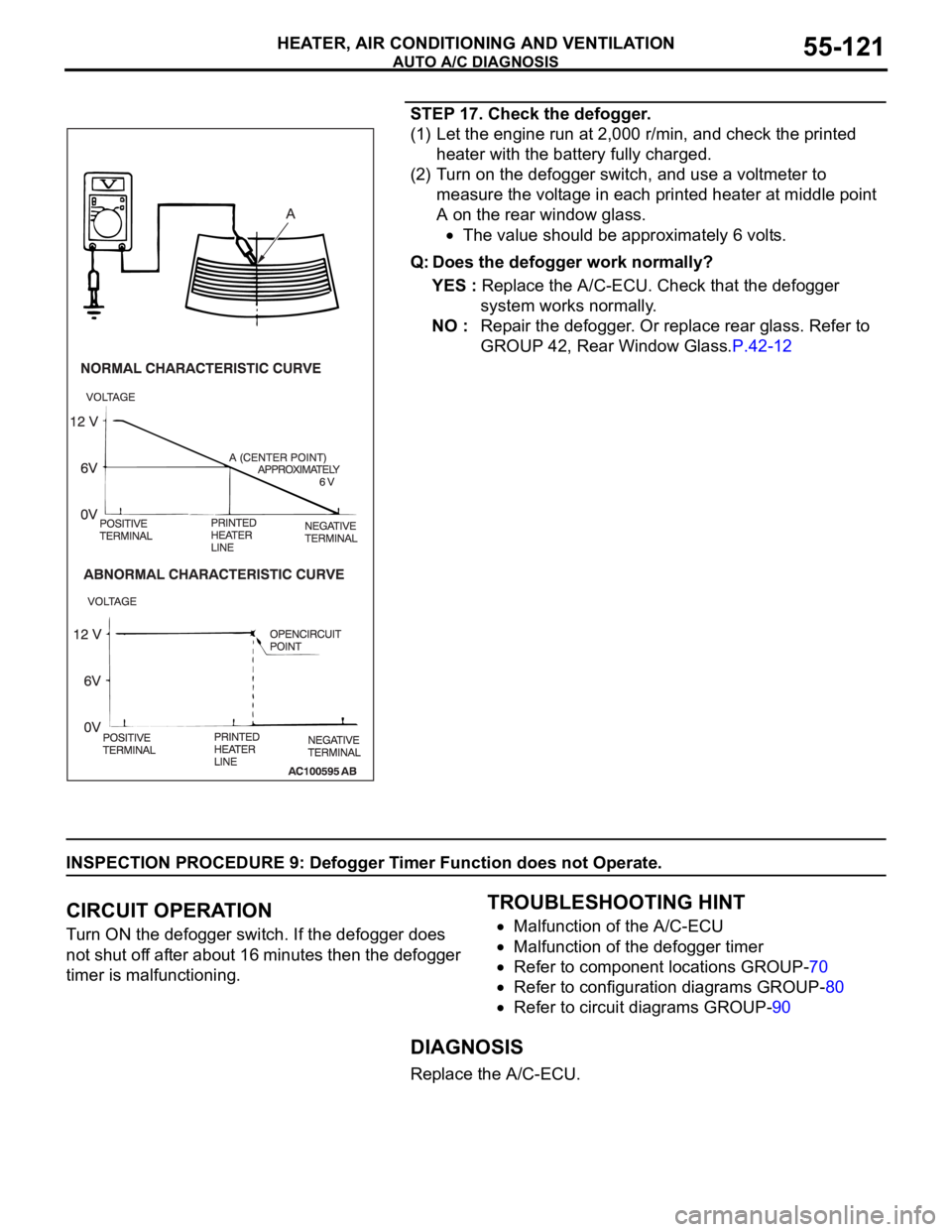
AUTO A/C DIAGNOSIS
HEATER, AIR CONDITIONING AND VENTILATION55-121
STEP 17. Check the defogger.
(1) Let the engine run at 2,000 r/min, and check the printed
heater with the battery fully charged.
(2) Turn on the defogger switch, and use a voltmeter to
measure the voltage in each printed heater at middle point
A on the rear window glass.
The value should be approximately 6 volts.
Q: Does the defogger work normally?
YES : Replace the A/C-ECU. Check that the defogger
system works normally.
NO : Repair the defogger. Or replace rear glass. Refer to
GROUP 42, Rear Window Glass.P.42-12
INSPECTION PROCEDURE 9: Defogger Timer Function does not Operate.
.
CIRCUIT OPERATION
Turn ON the defogger switch. If the defogger does
not shut off after about 16 minutes then the defogger
timer is malfunctioning.
.
TROUBLESHOOTING HINT
Malfunction of the A/C-ECU
Malfunction of the defogger timer
Refer to component locations GROUP-70
Refer to configuration diagrams GROUP-80
Refer to circuit diagrams GROUP-90
DIAGNOSIS
Replace the A/C-ECU.
Page 824 of 1500
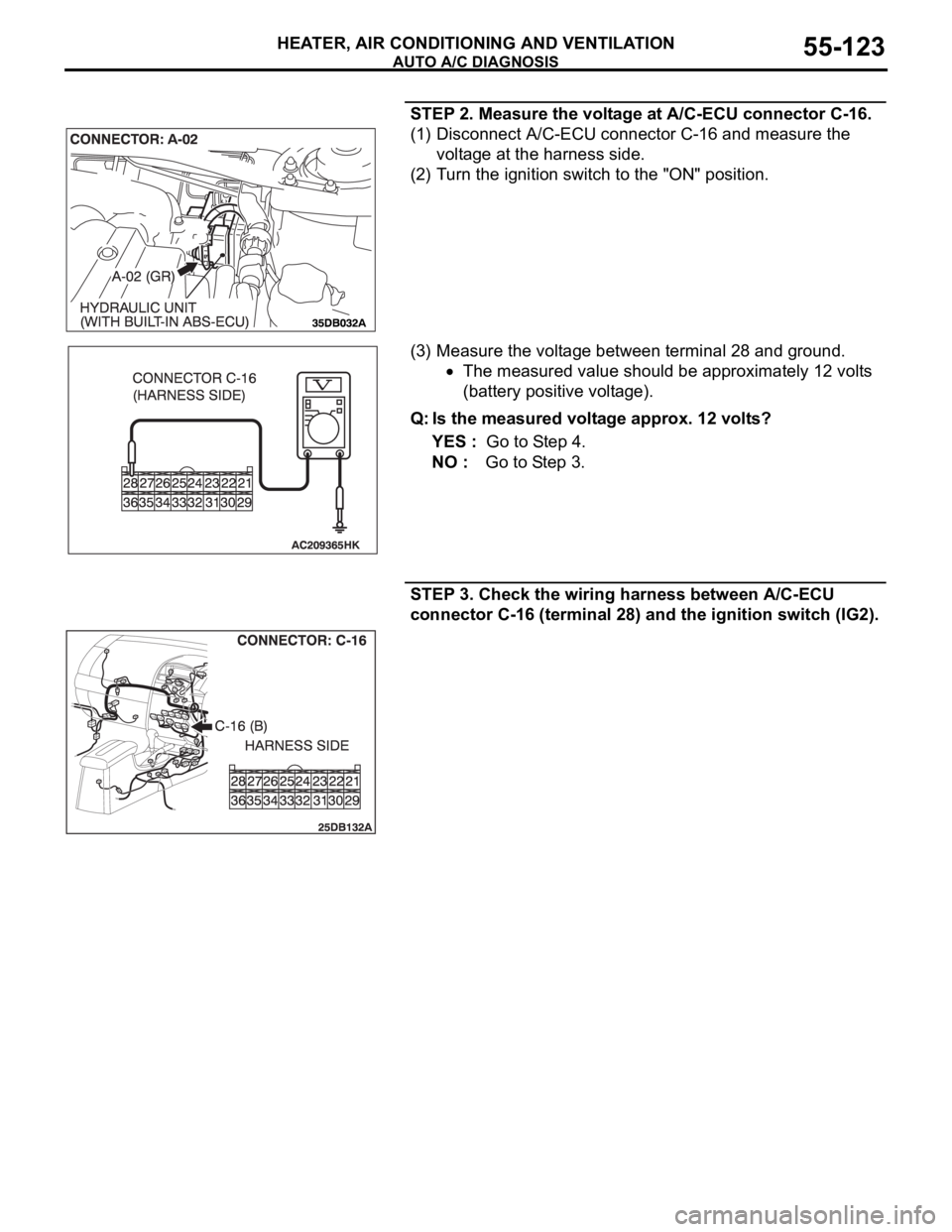
AUTO A/C DIAGNOSIS
HEATER, AIR CONDITIONING AND VENTILATION55-123
STEP 2. Measure the voltage at A/C-ECU connector C-16.
(1) Disconnect A/C-ECU connector C-16 and measure the
voltage at the harness side.
(2) Turn the ignition switch to the "ON" position.
(3) Measure the voltage between terminal 28 and ground.
The measured value should be approximately 12 volts
(battery positive voltage).
Q: Is the measured voltage approx. 12 volts?
YES : Go to Step 4.
NO : Go to Step 3.
STEP 3. Check the wiring harness between A/C-ECU
connector C-16 (terminal 28) and the ignition switch (IG2).
Page 825 of 1500
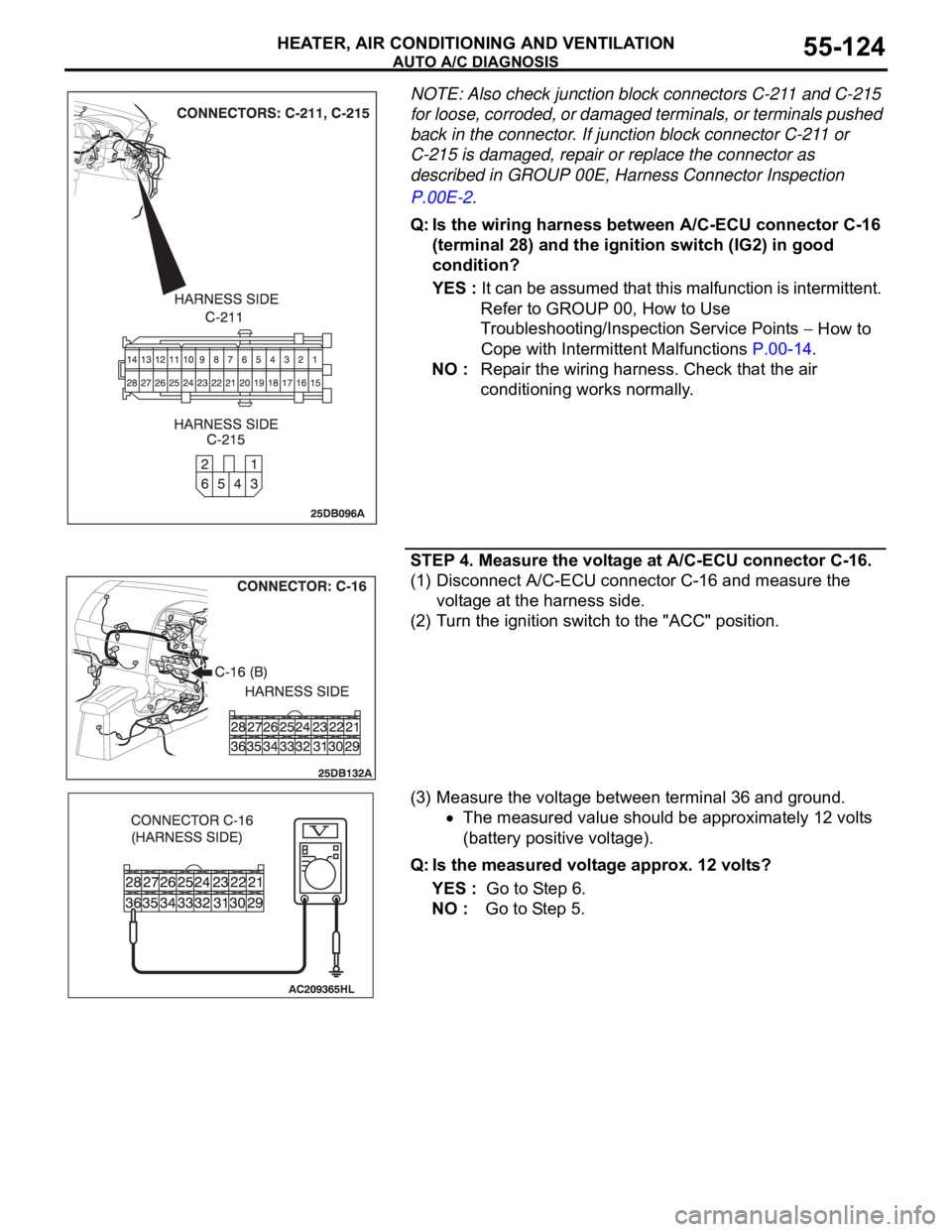
AUTO A/C DIAGNOSIS
HEATER, AIR CONDITIONING AND VENTILATION55-124
NOTE: Also check junction block connectors C-211 and C-215
for loose, corroded, or damaged terminals, or terminals pushed
back in the connector. If junction block connector C-211 or
C-215 is damaged, repair or replace the connector as
described in GROUP 00E, Harness Connector Inspection
P.00E-2.
Q: Is the wiring harness between A/C-ECU connector C-16
(terminal 28) and the ignition switch (IG2) in good
condition?
YES : It can be assumed that this malfunction is intermittent.
Refer to GROUP 00, How to Use
Troubleshooting/Inspection Service Points
How to
Cope with Intermittent Malfunctions P.00-14.
NO : Repair the wiring harness. Check that the air
conditioning works normally.
STEP 4. Measure the voltage at A/C-ECU connector C-16.
(1) Disconnect A/C-ECU connector C-16 and measure the
voltage at the harness side.
(2) Turn the ignition switch to the "ACC" position.
(3) Measure the voltage between terminal 36 and ground.
The measured value should be approximately 12 volts
(battery positive voltage).
Q: Is the measured voltage approx. 12 volts?
YES : Go to Step 6.
NO : Go to Step 5.
Page 827 of 1500

AUTO A/C DIAGNOSIS
HEATER, AIR CONDITIONING AND VENTILATION55-126
STEP 6. Measure the voltage at A/C-ECU connector C-15.
(1) Disconnect A/C-ECU connector C-16 and measure the
voltage at the harness side.
(2) Measure the voltage between terminal 3 and ground.
The measured value should be approximately 12 volts
(battery positive voltage).
Q: Is the measured voltage approx. 12 volts?
YES : Go to Step 8.
NO : Go to Step 7.
STEP 7. Check the wiring harness between A/C-ECU
connector C-15 (terminal 3) and the battery.
Page 828 of 1500
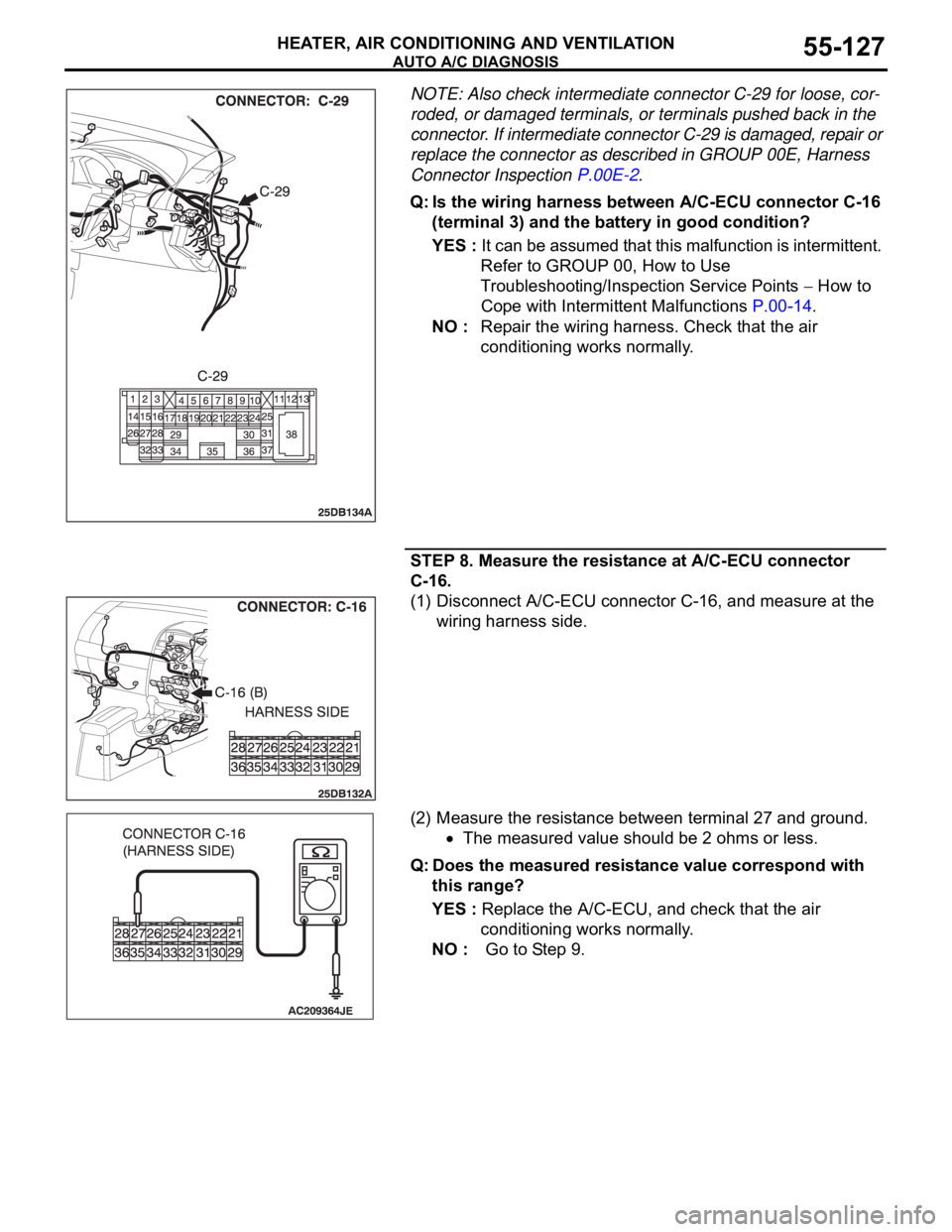
AUTO A/C DIAGNOSIS
HEATER, AIR CONDITIONING AND VENTILATION55-127
NOTE: Also check intermediate connector C-29 for loose, cor-
roded, or damaged terminals, or terminals pushed back in the
connector. If intermediate connector C-29 is damaged, repair or
replace the connector as described in GROUP 00E, Harness
Connector Inspection P.00E-2.
Q: Is the wiring harness between A/C-ECU connector C-16
(terminal 3) and the battery in good condition?
YES : It can be assumed that this malfunction is intermittent.
Refer to GROUP 00, How to Use
Troubleshooting/Inspection Service Points
How to
Cope with Intermittent Malfunctions P.00-14.
NO : Repair the wiring harness. Check that the air
conditioning works normally.
STEP 8. Measure the resistance at A/C-ECU connector
C-16.
(1) Disconnect A/C-ECU connector C-16, and measure at the
wiring harness side.
(2) Measure the resistance between terminal 27 and ground.
The measured value should be 2 ohms or less.
Q: Does the measured resistance value correspond with
this range?
YES : Replace the A/C-ECU, and check that the air
conditioning works normally.
NO : Go to Step 9.
Page 838 of 1500

AUTO A/C DIAGNOSIS
HEATER, AIR CONDITIONING AND VENTILATION55-137
CHECK AT A/C-ECU TERMINALM1552010300572
TERMINAL
NO.CHECK ITEM CHECKING REQUIREMENTS NORMAL CONDITION
1 Air mixing damper control motor When the air mix damper is
moved to the MAX. COOL
position. 10 V
When the air mix damper is
moved to the MAX. HOT
position. 0.5 V
2 Air mixing damper control motor When the air mix damper is
moved to the MAX. COOL
position. 0.5 V
When the air mix damper is
moved to the MAX. HOT
position. 10 V
3 Back-up power supply Always Battery positive voltage
4 Mode selection damper control
motor (DEF)When the damper is moved to
the FACE position. 0.5 V
When the damper is moved to
the DEF position. 10 V
5 Outside/inside air selection
damper control motor (outside)When the damper is moved to
the inside air recirculation
position.0.5 V
When the damper is moved to
the outside air induction
position.0 V (when the motor is
stopped)
6 Outside/inside air selection
damper control motor (inside)When the damper is moved to
the inside air recirculation
position.0 V (when the motor is
stopped)
When the damper is moved to
the outside air induction
position.0.5 V
8 Rear defogger relay Ignition switch: ON Battery positive voltage
9 Front blower relay Ignition switch: ON Battery positive voltage
10 A/C compressor relay A/C compressor relay: ON Battery positive voltage
11 Mode selection damper control
motor (FACE)When the damper is moved to
the FACE position. 10 V
When the damper is moved to
the DEF position. 0.5 V
12 A/C pressure sensor Ignition switch: ON 5 V
Page 839 of 1500

AUTO A/C DIAGNOSIS
HEATER, AIR CONDITIONING AND VENTILATION55-138
16 Potentiometer power supply Ignition switch: ON 5 V
17 Power transistor (BASE) When the blower speed
selection dial shows Maximum
air volume.1 V
18 Power transistor
(COLLECTOR)When the blower speed
selection dial shows Maximum
air volume.12.1 V
19 Photo sensor Ignition switch: ON 5 V
20 Sensors and potentiometers
groundAlways 0 V
21 Mode selection damper control
motor potentiometer inputWhen the damper is moved to
the FACE position. 4 V
22 Interior temperature sensor Ignition switch: ON 5 V
23 Ambient temperature sensor
inputWhen sensor temperature is
25
C (77F) [4 k]1.9 V
24 Air thermo sensor input When sensor temperature is
25
C (77F) [1.5 k]2.2 V
25 Photo sensor ground Ignition switch: ON 0 V
26 A/C pressure sensor at 2.6 MPa 3.9 V
27 Ground Always 0 V
28 Power supply to the ignition
switch (IG2)Ignition switch: ON Battery positive voltage
29 Air mixing damper control motor
potentiometer inputWhen the damper door is
moved to the MAX. HOT
position.1.4 V
30 Illumination ground Always 0 V
31 ILL power supply Lighting switch: ON Battery positive voltage
34 A/C pressure sensor ground Always 0 V
36 Power supply to the ignition
switch (ACC)Ignition switch: ON Battery positive voltage TERMINAL
NO.CHECK ITEM CHECKING REQUIREMENTS NORMAL CONDITION
Page 842 of 1500
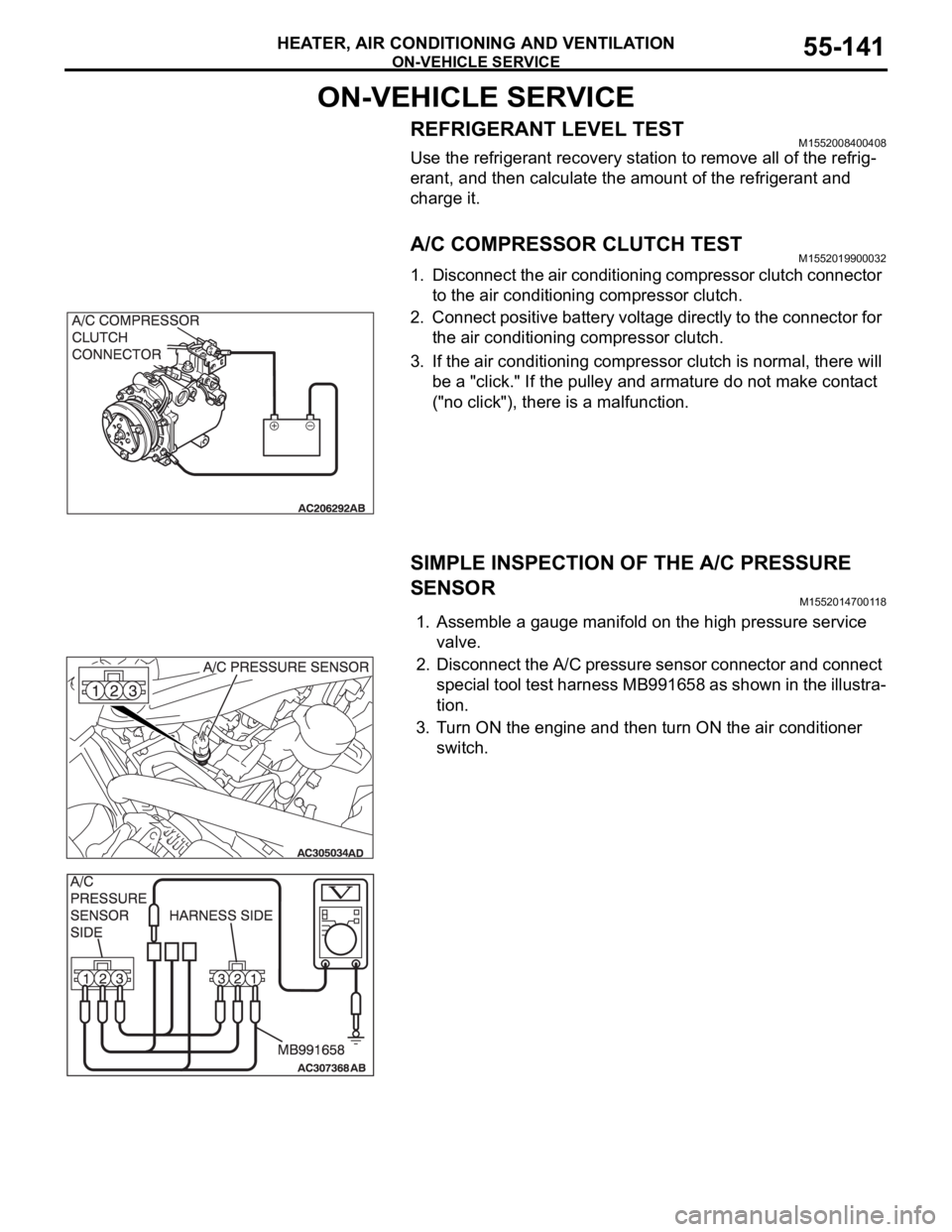
ON-VEHICLE SERVICE
HEATER, AIR CONDITIONING AND VENTILATION55-141
ON-VEHICLE SERVICE
REFRIGERANT LEVEL TESTM1552008400408
Use the refrigerant recovery station to remove all of the refrig-
erant, and then calculate the amount of the refrigerant and
charge it.
A/C COMPRESSOR CLUTCH TESTM1552019900032
1. Disconnect the air conditioning compressor clutch connector
to the air conditioning compressor clutch.
2. Connect positive battery voltage directly to the connector for
the air conditioning compressor clutch.
3. If the air conditioning compressor clutch is normal, there will
be a "click." If the pulley and armature do not make contact
("no click"), there is a malfunction.
SIMPLE INSPECTION OF THE A/C PRESSURE
SENSOR
M1552014700118
1. Assemble a gauge manifold on the high pressure service
valve.
2. Disconnect the A/C pressure sensor connector and connect
special tool test harness MB991658 as shown in the illustra-
tion.
3. Turn ON the engine and then turn ON the air conditioner
switch.
Page 849 of 1500
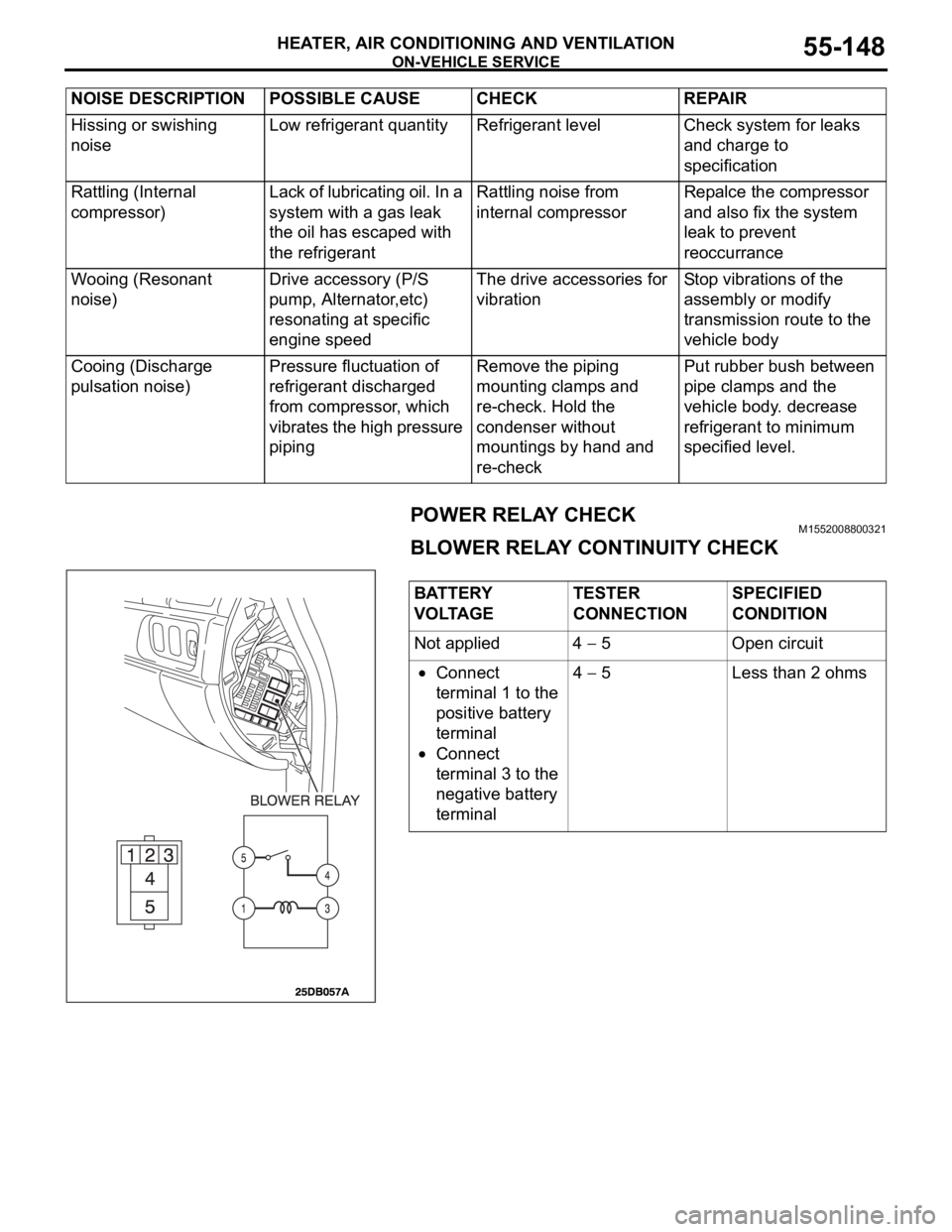
ON-VEHICLE SERVICE
HEATER, AIR CONDITIONING AND VENTILATION55-148
POWER RELAY CHECKM1552008800321
BLOWER RELAY CONTINUITY CHECK
Hissing or swishing
noiseLow refrigerant quantity Refrigerant level Check system for leaks
and charge to
specification
Rattling (Internal
compressor)Lack of lubricating oil. In a
system with a gas leak
the oil has escaped with
the refrigerantRattling noise from
internal compressorRepalce the compressor
and also fix the system
leak to prevent
reoccurrance
Wooing (Resonant
noise)Drive accessory (P/S
pump, Alternator,etc)
resonating at specific
engine speedThe drive accessories for
vibrationStop vibrations of the
assembly or modify
transmission route to the
vehicle body
Cooing (Discharge
pulsation noise)Pressure fluctuation of
refrigerant discharged
from compressor, which
vibrates the high pressure
pipingRemove the piping
mounting clamps and
re-check. Hold the
condenser without
mountings by hand and
re-checkPut rubber bush between
pipe clamps and the
vehicle body. decrease
refrigerant to minimum
specified level. NOISE DESCRIPTION POSSIBLE CAUSE CHECK REPAIR
BATTERY
VOLTAGETESTER
CONNECTIONSPECIFIED
CONDITION
Not applied 4
5 Open circuit
Connect
terminal 1 to the
positive battery
terminal
Connect
terminal 3 to the
negative battery
terminal4
5 Less than 2 ohms
Page 850 of 1500
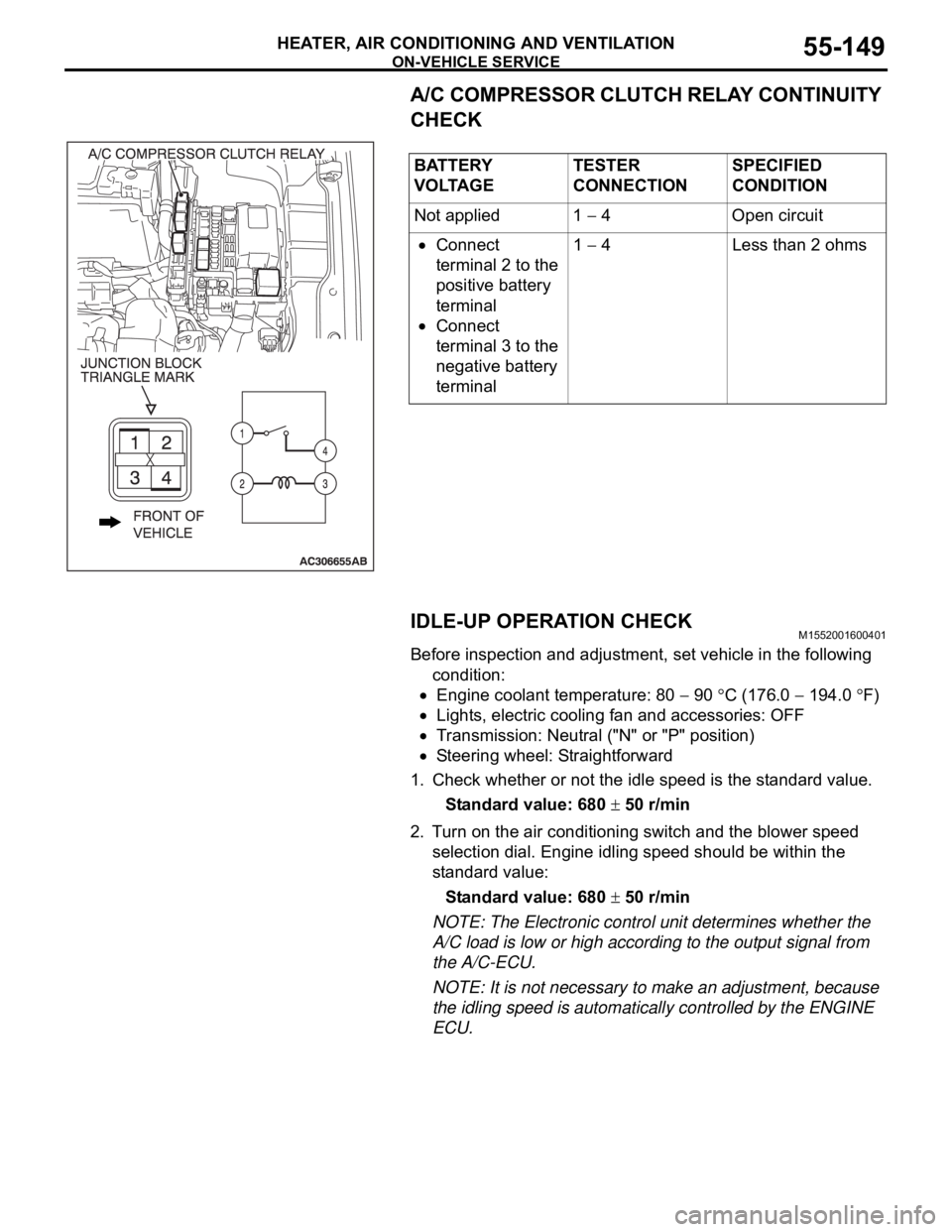
ON-VEHICLE SERVICE
HEATER, AIR CONDITIONING AND VENTILATION55-149
A/C COMPRESSOR CLUTCH RELAY CONTINUITY
CHECK
IDLE-UP OPERATION CHECK
M1552001600401
Before inspection and adjustment, set vehicle in the following
condition:
Engine coolant temperature: 80 90 C (176.0 194.0 F)
Lights, electric cooling fan and accessories: OFF
Transmission: Neutral ("N" or "P" position)
Steering wheel: Straightforward
1. Check whether or not the idle speed is the standard value.
Standard value: 680
50 r/min
2. Turn on the air conditioning switch and the blower speed
selection dial. Engine idling speed should be within the
standard value:
Standard value: 680
50 r/min
NOTE: The Electronic control unit determines whether the
A/C load is low or high according to the output signal from
the A/C-ECU.
NOTE: It is not necessary to make an adjustment, because
the idling speed is automatically controlled by the ENGINE
ECU. BATTERY
V O LTA G ETESTER
CONNECTIONSPECIFIED
CONDITION
Not applied 1
4 Open circuit
Connect
terminal 2 to the
positive battery
terminal
Connect
terminal 3 to the
negative battery
terminal1
4 Less than 2 ohms